 Multiple Choice Questions
Multiple Choice QuestionsTwo slits are separated by a distance of 0.5 mm and illuminated with light of wavelength λ = 6000 Ao. If the screen is placed at 2.5 m from the slits. The distance of the third bright fringe from the centre will be
1.5 mm
3 mm
6 mm
9 mm
D.
9 mm
Distance of nth bright fringe from the centre,
xn =
where n = 0, ± 1,±2,.....
The third bright fringe width from the centre,
x3 =
= 9 × 10-3 m
x3 = 9 mm
Light of two different frequencies whose photons
have energies 1 eV and 2.5 eV respectively, successively illuminate a metallic surface whose work function is 0.5 eV. Ratio of maximum speeds of emitted electrons will be
1 : 4
1 : 1
1 : 5
1 : 2
In the circuit shown in figure, when the input voltage of the base resistance is 10 V, Vb, is zero and Vce is also zero. Value of β is

133
154
196
105
Two radioactive materials X1 and X2 have decay constants 6 and 3A respectively. If initially they have the same number of nuclei, then the ratio of the number of nuclei of X1 to that of X2 will be after a time
A neutron in a nuclear reactor collides head on elastically with the nucleus of a carbon atom initially at rest. The fraction of kinetic energy transferred from the neutron to the carbon atom is
Assertion: Thermonuclear fusion reactions may become the source of unlimited power for the mankind.
Reason: A single fusion event involving isotopes of hydrogen produces more energy from nuclear fission of
If both assertion and reason are true and reason is the correct explanation of assertion.
If both assertion and reason are true but reason is not the correct explanation of assertion.
If assertion is true but reason is false.
If both assertion and reason are false.
Assertion: A ray of light is incident from outside on a glass sphere surrounded by air. This ray may suffer total internal reflection at second interface.
Reason: If a ray of light goes from denser to rarer medium, it bends away from the normal.
If both assertion and reason are true and reason is the correct explanation of assertion.
If both assertion and reason are true but reason is not the correct explanation of assertion.
If assertion is true but reason is false.
If both assertion and reason are false.
Assertion: As work function of a material increases by some mechanism, it requires greater energy to excite the electrons from its surface.
Reason: A plot of stopping potential (Vs) versus frequency (v) for different metals, has greater slope for metals with greater work functions.
If both assertion and reason are true and reason is the correct explanation of assertion.
If both assertion and reason are true but reason is not the correct explanation of assertion.
If assertion is true but reason is false.
If both assertion and reason are false.
Assertion: An n-type semiconductor has a large number of electrons but still it is electrically neutral.
Reason: An n-type semiconductor is obtained by doping an intrinsic semiconductor with a pentavalent impurity.
If both assertion and reason are true and reason is the correct explanation of assertion.
If both assertion and reason are true but reason is not the correct explanation of assertion.
If assertion is true but reason is false.
If both assertion and reason are false.
Assertion: Two point coherent sources of light S1 and S2 are placed on a line as shown. P and Q are two points on that line. If at point P maximum intensity is observed then maximum intensity should also be observed at Q.

Reason: In the figure of assertion the distance is equal to distance .
If both assertion and reason are true and reason is the correct explanation of assertion.
If both assertion and reason are true but reason is not the correct explanation of assertion.
If assertion is true but reason is false.
If both assertion and reason are false.
